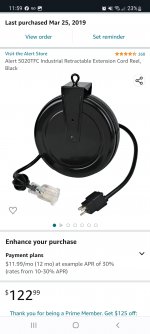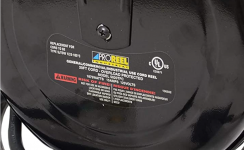In a woodworking forum I frequent a member is building a new shop and is now laying out his electricals. He intends to install several drops from the 10’ ceiling, he is asking for advice on layout.
Several members have suggested regular outlets with a 25’ retractable reel extension cord.
I feel like that is not a good idea. When I visualize that I see something like a 12 amp router or circular saw with a 6’ cord plugged into the 16 or 14 gauge extension cord, with only about 3’ or 4’ of the extension cord actually being splayed out.
So figuring the axle of the reel at maybe 8” diameter, with the diameter getting 3/4” bigger after every 3 wraps… that’s about ten wraps still within the enclosed reel… the equivalent of 20 current carrying conductors.
In conduit, we would have to derate the ampacity to 50% because of its reduced ability to dissipate heat. The reel would be even worse; each conductor has its own insulation layer, then every two ccc would have another insulation sheath around it. And, unlike conduit where the 20 conductors would travel away from any one spot, spreading out over about 21 feet; in the reel, the 20 conductors on the top of the axle would be 8” away from the conductors on the other side; all being contained in about 200 cubic inches of plastic).
I think a 25’ extension cord is fine when you have the bulk of the cord splayed out. But I think leaving the bulk wound up on most occasions is not wise.
Would you think there would be any issue or am I just being paranoid.
Several members have suggested regular outlets with a 25’ retractable reel extension cord.
I feel like that is not a good idea. When I visualize that I see something like a 12 amp router or circular saw with a 6’ cord plugged into the 16 or 14 gauge extension cord, with only about 3’ or 4’ of the extension cord actually being splayed out.
So figuring the axle of the reel at maybe 8” diameter, with the diameter getting 3/4” bigger after every 3 wraps… that’s about ten wraps still within the enclosed reel… the equivalent of 20 current carrying conductors.
In conduit, we would have to derate the ampacity to 50% because of its reduced ability to dissipate heat. The reel would be even worse; each conductor has its own insulation layer, then every two ccc would have another insulation sheath around it. And, unlike conduit where the 20 conductors would travel away from any one spot, spreading out over about 21 feet; in the reel, the 20 conductors on the top of the axle would be 8” away from the conductors on the other side; all being contained in about 200 cubic inches of plastic).
I think a 25’ extension cord is fine when you have the bulk of the cord splayed out. But I think leaving the bulk wound up on most occasions is not wise.
Would you think there would be any issue or am I just being paranoid.





